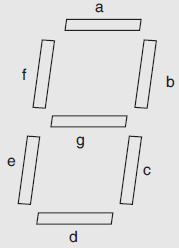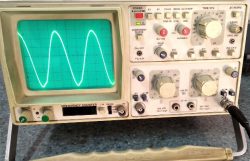The display devices are output devices to display the information in visual form by means of various types of display systems. In digital instruments, the output device of the instrument indicates the value of measured quantity using the digital display device. This digital display device may receive the digital information in any form but it converts the information in decimal form. The digital display device indicates the value in decimal digits directly. LEDs are most commonly used in digital displays for displaying alphanumeric characters. The LEDs have advantages such as low voltage, long life, high reliability, low cost, fast switching characteristics, etc.
Table of Contents
Classification of Display
The most commonly used display devices are CRT (Cathode Ray Tube), LED (Light Emitting Diode) and LCD (Liquid Crystal Display), etc. In the digital electronics field, the commonly used display devices are given as follows :
Types of display devices –
- Light Emitting Diode (LED)
- Liquid Crystal Display (LCD)
- Nixie Tube or Cold Cathode Displays
- Incandescent Displays
- Fluorescent Displays
- Liquid Vapour Based Display
- Segmented Gas Discharge Displays
Light Emitting Diode (LED)
A PN junction diode, which emits light when forward biased, is known as a light-emitting diode (abbreviated as LED). The emitted light may be visible or invisible. The amount of light output is directly proportional to the forward current. Thus, the higher the forward current, the higher is the light output. The schematic symbol of a light-emitting diode is shown in the figure shown below. The arrows, pointing away from the diode symbol represent the light, which is being transmitted away from the junction.
Liquid Crystals Displays
A liquid crystal is a material (usually, an organic compound) that flows like a liquid at room temperature but whose molecular structure has some properties normally associated with solids. As is well-known, the molecules in ordinary liquids have random orientation but in a liquid crystal, they are oriented in a definite crystal pattern. Normally, a thin layer of the liquid crystal is transparent to incident light but when an electric field is applied across it, its molecular arrangement is disturbed causing changes in falls on an activated layer of a liquid crystal, it is either absorbed or else is scattered by the disoriented molecules.
The above figure is shown, a liquid crystal ‘cell’ consists of a thin layer (about 10 mm) of a liquid crystal sandwiched between two glass sheets with transparent electrodes deposited on their inside faces. With both glass sheets transparent, the cell is known as transmittive type cell. When one glass is transparent and the other has a reflective coating, the cell is called reflective type. The LCD does not produce any illumination of its own. It, in fact, depends entirely on illumination falling on it from an external source for its visual effect.
Seven-Segment Display
A seven-segment display, or seven-segment indicator, is a form of an electronic display device for displaying decimal numerals that is an alternative to the more complex dot-matrix displays. Seven segment displays are widely used in digital clocks, electronic meters, and other electronic devices for displaying numerical information. A seven-segment display, as its name indicates, is composed of seven elements.
The seven segments are arranged as a rectangle of two vertical segments on each side with one horizontal segment on the top, middle, and bottom. Additionally, the seventh segment bisects the rectangle horizontally.
The above figure shows a seven-segment display. It is used to display alphanumeric characters. It consists of 7 rectangular light-emitting diodes designated by the letters a, b, c, d, e, f, and g. Each LED is called a segment because it forms a part of the character being displayed.
Nixie Tube or Cold Cathode Displays
These are also called as neon or gas-discharge displays. A nixie tube is an electronic device for displaying numerals or other information. The glass tube contains a wire-mesh anode and multiple cathodes. In most tubes, the cathodes are shaped like numerals.
The basic construction of a digital indicator tube is shown above figure. It is a cold cathode glow discharge tube, which is popularly known as Nixie which is the trademark of M/s Burrough’s corporation U.S.A. The display works on the principle that when a gas breaks down, a glow discharge is produced. A gauze electrode with a positive voltage supply functions as an anode and there are 10 separate wire cathodes, each in the shape of s numeral form 0 to 9. Applying power to one cathode surrounds it with an orange glow discharge. The tube is filled with a gas at low pressure, usually mostly neon and often a little mercury and/or argon, in a Penning mixture. At the base of the tube is a set of contacts, one each for the anode and the many cathodes.
Incandescent Displays
Incandescence has been a basic process of producing light for several decades. Incandescent displays can be made in a wide range of sizes and colours. The main drawback of incandescent displays is poor reliability due to the failure of segments. However new methods and materials have improved the reliability of such displays. Many newer incandescent displays have seven segment filaments contained within a single vacuum envelope and are compatible with standard TTL voltages. Such displays are characterized by bright output, simple technology and compatibility with ICs, but at very low operating speeds. Multiplexing is not very advantages for such displays. It is because each display segment usually needs a diode to avoid leakage paths.
Fluorescent Displays
These devices are properly called “VFDs” or Vacuum Fluorescent Displays. A vacuum fluorescent display (VFD) is a display device used commonly on consumer-electronics equipment such as video cassette recorders, car radios, and microwave ovens. Invented in Japan in 1967, the displays became common on calculators and other consumer electronics devices. Unlike liquid crystal displays, a VFD emits a very bright light with high contrast and can support display elements of various colours. VFDs can display seven-segment numerals, multi-segment alpha-numeric characters or can be made in a dot-matrix to display different alphanumeric characters and symbols.
Fluorescent displays are ideal for multiplexing due to their low current (about 1 mA) and voltage (about 30 V) requirements. Their typical colour is blue-green with the character heights up to 15 mm. These displays are mainly employed in calculators.
Liquid Vapour Based Displays
Liquid vapour based display system is the latest edition of the digital display technology. The arrangement is consisting of a transparent and volatile liquid filed in between two parallel glass plates. The front and the rear glass are sealed with the help of suitable spacers. Internal surface of the front glass is made rough whereas the outer surface of the rear glass is painted black to provide dark background. The reflective index of glad as well as that of the liquid contacts is the same. A thin transparent electrode dipped inside the liquid is heated by supply voltage as shown in the below figure.
Segmented Gas Discharge Displays
Segmented gas discharge displays work on the principle of gas discharge glow, similar to the case of Nixie tubes. They are mostly available in seven-segment or fourteen-segment form, to display numeric and alphanumeric character.
Since these devices require high voltages, special ICs are developed to drive them. Each segment of the seven-segment display formed on a base has a separate cathode. The anode is common to each member of the seven-segment group which is deposited on the covering faceplate. The space between the anodes and cathodes contains the gas. For each group of segments, a ‘keep-alive’ cathode is also provided.
For improving the switching speeds of the display a small constant current is passed through this keep alive cathode, which acts as a source of ions. Pins are connected to the electrode at the rear of the base plate, with the help of which external connections can be made.







